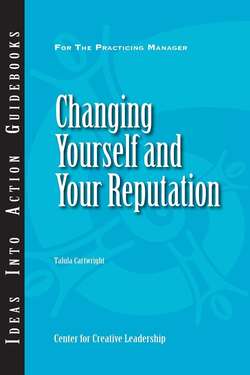Читать книгу Changing Yourself and Your Reputation - Talula Cartwright - Страница 9
ОглавлениеThe Challenge of Personal Change
In order to change, you have to first decide for yourself that you need to change. Change is always a choice, of course. You could remain just as you are. Stability is easier than progress, and you certainly wouldn’t want to get worse! Since you have the freedom of choice, you also have the responsibility to choose well. The old way is always more familiar, and it creates a kind of default setting that is all too easy to snap back into. It takes work to make a real change.
To develop your capacity to lead, you must start with an assessment of your strengths and weaknesses. In other words, to get where you want to go, you need to know where you are. Then you will be ready to create a plan to optimize and leverage your strengths and to work on developing better skills in other areas.
As you create your plan, you may notice a curious paradox: Often your strengths and weaknesses relate to the same quality. If you are known for your flexibility, for example, you may also get feedback that you are indecisive. If you work to alleviate your indecisive behaviors, you may inadvertently diminish the favorable view that flexibility is one of your strengths. Any developmental plan of action you take should not only improve a weakness but also maintain a strength. If the change to the new desired behavior is too drastic, it is actually possible to damage people’s perception of a strength—to sacrifice it on the altar of improved performance!
Working on a personal quality presents specific challenges. The fact is that most personal qualities in and of themselves are neither strengths nor weaknesses. It’s the context in which you practice your leadership that often creates in the minds of others a judgment of whether a specific quality is good or bad. In one work environment it may pay for a leader to be more flexible—for example, during the early stages of product development when innovative ideas need to be encouraged and solicited. In a different case, the quality of decisiveness may be more highly valued—for example, when dealing with the publicity surrounding a crisis in your organization. In such an environment, a leader would need to react smoothly to rapidly changing circumstances. It would be essential for the leader to be more decisive, so flexibility could actually undermine effectiveness.
360-Degree Assessments
Effectiveness is judged differently in different environments. A good assessment is key to inform you of how you are being judged. It lets you know whether you need to change yourself, change the way you present yourself, or do a bit of both. You may find one of the following CCL assessments helpful.
Executive Dimensions assesses top-level leadership behaviors. A straightforward feedback report displays a participant’s data grouped into three factors: leading the business, leading others, and leading by personal example. These factors are further divided into sixteen competencies, containing a total of ninety-two items.
Benchmarks assesses sixteen skills and perspectives that CCL researchers have identified as critical to successful management. In addition, it helps you identify five potential flaws that may stall or derail a promising career.
